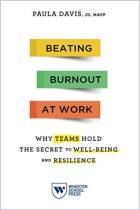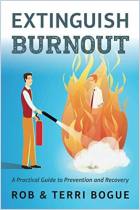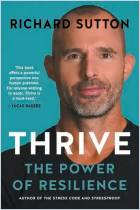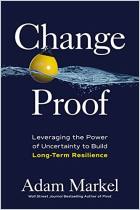Join getAbstract to access the summary!

Join getAbstract to access the summary!
Jacinta M. Jiménez
The Burnout Fix
Overcome Overwhelm, Beat Busy, and Sustain Success in the New World of Work
McGraw-Hill, 2021
What's inside?
Learn practices that foster resilience and prevent work burnout altogether.
Recommendation
Burnout is a pervasive social problem in the United States. It leaves workers feeling exhausted and overwhelmed. In some cases, it can even cause death. Psychologist and Stanford University graduate Jacinta M. Jiménez believes today’s organizations need to do more than just treat the symptoms of burnout – they need to learn to prevent it altogether. In this practical text, Jiménez offers tools to stop burnout before it begins. The key, she argues, is to foster resilience on both an individual and an organizational level. With her science-backed “PULSE” practices, you can learn to lead a more purpose-driven life and support your team members’ well-being.
Take-Aways
- Success in the modern workplace takes more than grit – it requires resilience.
- Develop five capabilities to avoid burnout.
- Cultivate a healthy performance pace.
- Reduce distracting thoughts and work toward mental clarity.
- Prioritize leisure time.
- Strengthen your social wellness.
- Manage your energy carefully and live a purpose-driven life.
- Lead healthy teams by embracing agency, benevolence and community.
Summary
Success in the modern workplace takes more than grit – it requires resilience.
In today’s global, hyperconnected world, people often believe that career success requires them to take on unsustainable volumes of work and be constantly available to tackle work-related tasks. Yet when you exert an unsustainable level of effort for too long, burnout often results. A Deloitte survey revealed that more than three-quarters of workers had experienced burnout in their jobs. High levels of workplace stress lead to an estimated 120,000 deaths per year.
“It doesn’t matter if you work harder or smarter; if you neglect to also nurture a steady personal pulse, your success will be short-lived.”
Organizations often focus on how to help employees recover from workplace burnout, but what they really need to do is teach their people how to avoid it altogether. That goal calls for learning ways to cultivate personal and professional resilience.
Develop five capabilities to avoid burnout.
To keep yourself from suffering from burnout, you should engage in “personal PULSE practices” – strategies for nurturing inner resilience. You must Pace yourself, Undo unhelpful thought patterns, engage in Leisure activities, build a Support system and Evaluate how you spend your time. If you follow the PULSE practices, you’ll improve your capabilities in five key areas of your life:
- Behavioral – Boost your professional and personal growth by developing a healthy performance pace.
- Cognitive – Rid yourself of unhealthy thought patterns.
- Physical – Embrace the power of leisure as a strategy to protect and restore your reserves of energy.
- Social – Build a diverse network of social support to make yourself more adaptable and improve your thinking.
- Emotional – Don’t let others control your priorities or time. Evaluate the effort you exert, and take control yourself.
Cultivate a healthy performance pace.
People tend to romanticize successful people, framing them as fundamentally different from ordinary individuals. But while it’s tempting to assume that J.K. Rowling, for example, had overnight success with her Harry Potter series, she actually worked on the first book for seven years, and faced rejections from a dozen publishers. Most successful people achieve their dreams via “deliberate practice”: They tackle their goals by breaking them into smaller concrete steps to help avoid cognitive and emotional exhaustion.
“We love the idea of a ‘natural-born talent’ who defies normal human capabilities. But does our love affair with mavericks make sense?”
Create a framework to ensure you sustainably work toward your goals via the “three P’s”:
- Plan – Assess your skills and knowledge levels. Then, progressively push yourself slightly outside your comfort zone as you progress toward bigger goals. Keep goals realistic, feasible and specific.
- Practice – Commit to continuous learning, treating your discovery process as a series of experiments. Get feedback and approach your experiments with deep focus. Don’t fear failure, as you can learn from it. Keep a log, consistently tracking your progress and learning.
- Ponder – Once you’ve learned via experimentation and gathered feedback, leverage this knowledge to help you achieve your broader goal, and improve your approaches to strategy and experimentation. Ask yourself what did and didn’t work for you in the past, and how you could improve results in the future. Don’t forget to celebrate your small achievements as you approach success.
Reduce distracting thoughts and work toward mental clarity.
Rid yourself of stress-inducing cognitive distractions by embracing the “three C’s” of mental clarity:
- Curiosity – Be curious about your thought patterns. Identify recurring thoughts. Then ask yourself if they’re grounded in reality and if you can find evidence to support your assumptions. Noticing cognitive errors helps you cultivate greater self-awareness.
- Compassion – Overcome negative self-talk by practicing self-compassion. Rather than fixating on the flaws you see in yourself, talk to yourself with kindness, the way you might talk to a close friend.
- Calibration – Once you are more aware of the quality of your thoughts and have cultivated a broader, more realistic perspective on a given situation, ask yourself how you’d like to respond. For example, perhaps you’d like to act with compassion. Or you simply realize that you need more information.
Cultivate more mental clarity and awareness by:
- Stacking habits – If you’d like to embrace healthier habits, try bundling those new habits with ones you already engage in regularly, such as brushing your teeth.
- Scheduling reminders – Program your phone to remind you to check in with yourself three times a day, creating space to reflect on your thoughts.
- Breathing – Take long, deep inhalations and exhalations before reflecting.
- Writing down your thoughts – When engaging in the three C’s, write one or two sentences about each step.
- Learning about cognitive mistakes – People make several types of common errors. For example, are you engaging in binary thinking? Are you making assumptions about what others are thinking?
- Sticking with self-compassion – Being kind to yourself might feel awkward initially, but research confirms its positive benefits: increased levels of resilience, motivation and positive emotions, as well as a decreased tendency to get overwhelmed.
- Being consistent – If you practice the three C’s regularly, you can powerfully transform your neural pathways and boost your vitality.
Prioritize leisure time.
Media mogul Oprah Winfrey may have a never-ending to-do list, but she makes a point of unplugging from work and spending time in nature – going for walks with her dogs and working in her vegetable garden. The ability to enjoy stress-free leisure time is essential for Oprah, as it allows her to keep calm and centered, which, in turn, helps her handle the challenges life and work throw her way.
If you want to protect yourself against burnout and improve your leadership skills, you too should find ways to prioritize leisure. Overcome the harmful myth that constantly working longer, faster and harder is the key to success.
“We mistake busyness for productivity. We value volume of output over the value of output. We no longer judge others by the quality of their responses – rather, we focus on how fast they respond.”
Create more space for stress-busting leisure activities by prioritizing the “three S’s” in your everyday life:
- Silence – Take control over the way you use your technological devices, reducing the mental fatigue you might experience from an unnecessary onslaught of information and alerts. You can do this in small ways (such as not checking your phone when standing in a line) and in bigger ways (such as going on a meditation retreat).
- Sanctuary – Most Americans spend 93% of their time inside. This is unfortunate, since time you spend in nature decreases the stress-hormone cortisol and improves your mood, creativity, immunity and vitality. Schedule at least 20 to 30 minutes in nature per week, and try to leave your devices at home.
- Solitude – Choose to spend time alone. Doing so activates your brain’s default mode network, improving your cognitive abilities by slowing down sensory input. Solitude can lead to greater levels of self-awareness, creativity and mental clarity.
Strengthen your social wellness.
Social wellness – when you feel you belong and can securely access support from your community – is an important contributor to good health. When you feel socially excluded, you activate the same regions in your brain that respond to physical pain — the insula and the anterior cingulate cortex. Research shows that workers who feel socially ostracized are less satisfied and committed to their work, and experience higher levels of physiological distress symptoms like headaches, muscle tension and back pain. By contrast, workers who feel a high sense of social belonging perform 56% better, take 75% fewer sick days and are 50% more likely to stay at their current jobs.
“Loneliness doesn’t target a specific personality group such as introverts or extroverts — it can affect anyone. No one is immune to loneliness.”
Decrease your risk of burnout and overcome feelings of social exclusion by embracing the “three B’s” of secure support:
- Belonging – Strengthen your sense of belonging by actively working to be more compassionate. Display it cognitively by understanding others’ perspectives. Express it emotionally by empathizing with others, and show motivated compassion by strengthening your desire to take action to help others. Research shows that if you consistently practice loving kindness meditation (LKM) – mentally repeating phrases or sentiments expressing goodwill and care toward others – you’ll strengthen your sense of social well-being.
- Breadth – Create a visual map of your “circles of support” by drawing four concentric circles: Place the names of those to whom you feel closest in the innermost circle, those who support you consistently during tough times in the second circle, and those with whom you engage regularly, but don’t view as confidants, in the third circle. Acquaintances go in your outermost circle. Notice the circles where support seems lacking, and try to address those gaps by expanding your network. You may want to join new hobby-centered communities or change your daily patterns of social interaction, such as choosing to leave your neighborhood for lunch.
- Boundaries – Reflect on your personal values, which illustrate your priorities. Choose the five that are most important to you. Consider what you need to do to cultivate more of these values in your life. Think about actions that would detract from these values. Using this information, write down your “boundary rules.” If, for example, you prioritize your family, you might refuse to take calls at home during certain hours. Make an effort to respect others’ boundaries, just as you’d expect people to respect yours.
Manage your energy carefully and live a purpose-driven life.
Overcome the myth that expending more effort is always better, and effectively manage your energy by embracing the “three E’s”:
- Enduring principles – Identify a set of principles that can guide you in your current life stage. First, list the values and the skills you currently view as most relevant to your goals. Next, define the meaning behind the things you wish to pursue. Combine these elements to craft a mission statement to guide your actions. Use the following template: “Because I value X, I want to use my skills of Y to accomplish Z.” Finally, develop three principles, such as “practice gratitude” or “practice nonattachment,” to which you can commit as you work toward embodying your mission statement.
- Energy expenditure – Take a week to assess how you spend your energy by tracking your activities, the people with whom you spend time and the environments you’re navigating. Determine how they make you feel. Rate these feelings on a scale of one to 10. If you realize certain situations, activities or people make you feel depleted, schedule more activities and encounters that energize you. Healthy relationships tend to restore your energy, and engender positive feelings such as mutual trust, respect and support.
- Emotional acuity – Resist the tendency to ignore your emotions and embrace false positivity. Let yourself experience your full range of emotions, which will help you feel increased empathy for others and become a better problem solver. Strengthen your emotional intelligence by learning to better identify the emotions you feel. Start, perhaps, by learning a new word to describe an emotion every week. Treat your emotions as valuable information, and consider what they might be telling you.
Lead healthy teams by embracing agency, benevolence and community.
Lead resilient teams by cultivating a workplace culture that prioritizes the needs of people, and by employing the “ABC’s of Steady Pulse Teams And Organizations”:
- A is for agency – Give team members a sense of agency by clarifying your expectations (explicit and implicit) for each individual’s role, keeping the workloads and demands you make reasonable and feasible, and providing employees with opportunities to engage in professional and personal development.
- B is for benevolence – Commit to doing no harm. Employ practices that rest on openness, trust, respect and equity in the workplace. Recognize employees for their accomplishments, and don’t tolerate dishonesty or unfairness.
- C is for community – People find motivation at work through their desire to create positive social connections. Embrace practices that improve team members’ feelings of belonging, social inclusion and psychological safety.
“How can my organization improve our employee experience to uncover and implement a fixed set of practices that bolster individual, team and organizational resilience?”
Leaders who aim to put people first must commit to implementing practices that will increase resilience throughout all levels of their organizations. Use design thinking to continually improve the experience of people on your teams. Identify areas in need of improvement, develop solutions to bolster resilience levels, and deploy your solutions in the form of carefully monitored wellness initiatives.
About the Author
Dr. Jacinta M. Jiménez is a Stanford University and PGSP-Stanford PsyD Consortium graduate, a board-certified leadership coach and psychologist.
This document is restricted to personal use only.






















Comment on this summary